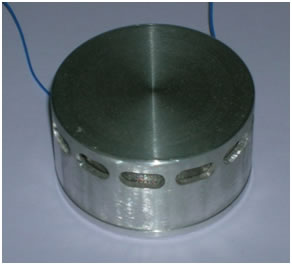

NH3 is one of the highly toxic gases which is widely used in various industrial applications. It causes irritation in nose and throat, and in extreme case causes severe lungs problem (pulmonary edema). Nanocrystalline SnO2 thin film based portable sensor detects NH3 from 5 ppm onwards at room temperature with fast response and recovery. The sensor works on the principle of increase in electrical resistance upon a chemical interaction with NH3.
Commercially available SnO2 gas sensors for NH3 are usually operated at high temperature to achieve reversibility and fast response. Shortcomings of high temperature operation of the sensor are: shorter life time, does not have portability and is not favorable in explosive environment.
Gas sensors are usually operated at high temperature to achieve fast response and reversibility and this leads to shorter lifetime of the sensor. Nanocrystalline SnO2 thin films fabricated from the thermal decomposition of Langmuir-Blodgett (LB) film precursor, exhibit room temperature gas sensitivity comparable to that required for air quality monitoring. LB technique offers control over SnO2 film thickness and crystallite size. By controlling the crystallite size and film thickness room temperature operation is achieved. The sensor is specific to NH3 gas at room temperature and shows fast response and recovery without any carrier gas flow. The stability studies of the sensor indicated that these sensors are stable at least for a year with no significant change in sensitivity.
| Sr. No. | Specification | Value |
|---|---|---|
| 1 | NH3 detection range | 5-40 ppm |
| 2 | Operating temperature | Room temperature |
| 3 | Safe operating temperature | 25-50°C |
| 4 | Response time (time to reach 90% of the resistance change) | 40 sec |
| 5 | Recovery time (time to reach 10% of the resistance change) | 20 min |
| 6 | Response at 5 ppm NH3 [(Rgas - Rair)x100]/Rair | 10-15% |
| 7 | Selectivity for NH3 (comparison to CH4, CO2, H2S, SO2, H2 etc.) | Detectable decrease in current only for NH3 among these gases |
| 8 | Life time under operating conditions | ~ 1 year |
NH3 is one of the highly toxic gas, which is widely used in various industrial applications. It causes irritation in nose and throat and in extreme case it causes severe lungs problem (pulmonary edema). Its long-term (8 h) and short-term (10 minutes) exposure limits are 25 and 50 ppm respectively. The nanocrystalline tin oxide (SnO2) thin film based sensor detects NH3 with high sensitivity, is selective to NH3 among other reducing gases, and is stable for more than 1 year. Commercially available SnO2 gas sensors are usually operated at high temperature to achieve reversibility and fast response. High temperature operation causes shorter life time and not favorable in explosive environment.
The sensor works on the principle of change in electrical resistance of nanocrystalline SnO2 thin film upon chemical interaction with NH3. This change is calibrated and displayed directly on a monitor as NH3 concentration.
The sensor element is nanocrystalline SnO2 thin film which is prepared by using Langmuir- Blodgett (LB) film precursors. Multilayer LB films (100 ± 20 layers) of ODA–stannate complex deposited on quartz are decomposed at 600 °C in the presence of ambient oxygen.
Nanocrystalline SnO2 surface has a net negative charge due to the large number of surface species O2-,O- present on it. NH3 which is a mild reducing gas, a polar molecule containing partial positive charge on its H atoms. When NH3 gas is injected into the gas testing chamber containing SnO2 thin film, it reduces the mobility of the electrons in SnO2, thereby increasing the resistance. This makes the sensor unique and specific to ammonia at room temperature.
SPECIFICATIONS
| Sr. No. | Specification | Value |
|---|---|---|
| 1 | Drift in base current | 2-3 % |
| 2 |
Sensitivity (towards NH3) S=((RNH3-Rair)x 100)/Rair |
10-15 % at 5 ppm of NH3 |
| 3 | Response time | 40 sec |
| 4 | Recovery time (after opening of stopcocks, without any carrier gas flow) | 20 min for 90 % recovery |
| 5 | Range of the sensor | 3-40 ppm |
| 6 | Reproducibility after a year (towards NH3) | Sensitivity intact |
| Response time | 200 sec | |
| Recovery time | 1 hr | |
| 9 | Repeatability | 90% |
| 10 | Percentage error in sensitivity | 10-15% |
| 11 | Sensor Housing | Water and light proof |
RAW MATERIALS
EQUIPMENTS
INFRASTRUCTURE
SPACE
POWER
MANPOWER

